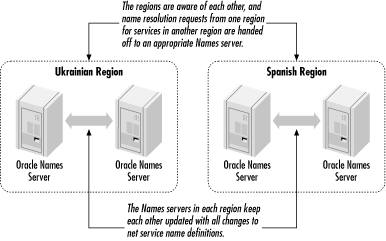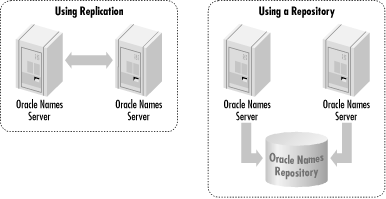| Centralized naming uses Oracle Names , which is a soon-to-be obsolete Net8 product developed by Oracle that allows you to centralize net service name resolution. Instead of looking up a net service name in a tnsnames.ora file on the client, Net8 can query a centrally managed Names server. The obvious advantage to using Oracle Names is that you are free to change net service name definitions without having to push tnsnames.ora files out to all your clients .  | Support for Oracle Names is being quickly phased out in favor of the LDAP solution represented by OID. The terminal release of Oracle Names will be 8.2. If you are thinking of implementing Names, don't. Use OID instead. If you are currently running Names, you should be planning your switch to an LDAP-based solution. | | 2.3.1 Redundancy and Scalability For purposes of redundancy and scalability, you can have multiple Oracle Names servers running at one time. Net service name definitions can be automatically replicated to all Names servers. That way, if any one server goes down, clients will still be able to use the others. You may also distribute the client load over those multiple Names servers. A large distributed environment might have multiple Names servers divided into several regions . Each region would be administered separately, but communication would still occur to ensure that any Names server could resolve any net service name. Figure 2.3 illustrates such an environment. Figure 2.3. Responsibility may be delegated by configuring an Oracle Names environment with multiple regions  Within a region, names are replicated between Names servers. In addition, Oracle Names can be configured so that requests for names in another region are directed to a Names server in that other region. While Figure 2.3 shows regions in terms of geography, a region in Oracle Names can correspond to any arbitrary division you wish to make. For example, a chemical company might place its research arm and its manufacturing arm into separate "regions" even though they are both physically located in the same city. 2.3.2 Name Storage You have two choices as to how Oracle Names stores and propagates net service name definitions: -
Each Oracle Names server can store this information in memory, replicating it to other Oracle Names servers whenever it changes. -
You can store net service name definitions in an Oracle database that acts as a central repository for Oracle Names. Figure 2.4 contrasts these two approaches. Figure 2.4. You can replicate net service names between Names servers or store them in a central repository  To define net service names to a Names server, you issue a series of commands using the Names Control ( namesctl ) program. For example, the following command, which is really one long line and not three shorter ones, registers the net service name projects : REGISTER projects -t oracle_database -d (DESCRIPTION=(SOURCE_ROUTE=OFF)(ADDRESS_ LIST=(ADDRESS=(PROTOCOL=TCP)(HOST=jonathan.gennick.org)(PORT=1521)))(CONNECT_ DATA=(SERVICE_NAME=jonathan.gennick.org)(SRVR=dedicated))) If you're using replication, and you define a net service name to one name server, that definition will be replicated to all the other name servers in the region. If you're using a central repository, the definition is recorded in the database where it will eventually be read by the other Names servers in the region. The advantage of using a central repository is that if all Names servers in a region go down, you don't lose your net service name definitions. When replication is used, if one Names server is stopped and restarted, it will retrieve the net service name definitions from one of the other Names servers in the same region. But if all the Names servers are stopped at the same time, you will have to reregister all your net service name definitions. |